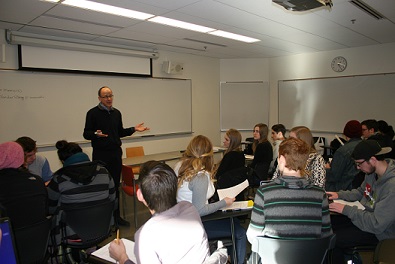What is a FIG seminar like?
What the seminar is:
Seminar 101, “Perspectives on Learning,” is the core of the FIG Program. The FIG seminar is a regular college class that meets in a classroom with up to 25 students and one instructor. The FIG seminar's two elective credits count toward the total credits needed for graduation. Students receive a letter grade that is calculated into their GPA. See "How do the credits work?" below.

What the seminar is not:
It is important to note that the seminar is not a study session for the larger GUR courses! While it is true that the seminar may draw upon concepts from the linked general education courses, the seminar is not designed to merely make connections between the two GURs. It is a class with college-level expectations, learning objectives, and assignments (see "What will I learn?").
What will I learn?
Each seminar has the same learning goals as itemized below; however, each seminar is taught by a different instructor who brings unique experiences and teaching strategies to each class. Also, the combination of GUR courses in each FIG will affect the subjects discussed, researched, and evaluated in each of the seminars.
In the FIG seminar, students will:
Ask questions to gain a deeper understanding of concepts in different fields of study.
Example:
In the Frames of Mind cluster, the two linked courses are Psychology and Anthropology. Students will develop and examine questions related to both fields and then research a particular issue for a paper or presentation.
Develop academic skills that can prepare them for future courses.
Examples:
- Learn to evaluate information from a variety of sources in seminar discussions and by doing library research
- Communicate ideas by writing a paper, making an oral presentation, or participating in class discussions
- Work with other students on group projects or in-class activities
- Meet with GUR instructors in a seminar setting
Identify college career goals and create a plan to achieve them.
Examples:
- Plan, with guidance, future course schedules
- Explore career resources available on campus
How do the credits work?
The college credit system probably is different from what students are used to in high school. Instead of taking a certain number of classes each quarter, students sign up for a variable number of credits. Each class varies as to how many credits it is worth, and a full time student may have approximately 12-16 credits each quarter. Students may take elective credits that count toward the total number of credits needed (180) for graduation. This total includes GUR courses, courses for majors, and other elective credits. The FIG seminar's 2 elective credits count toward the total credits needed for graduation and result in a letter grade that is calculated into the student's GPA. For more details on credits, see the Academic Advising website.
For instance, a student signing up for the "Frames of Mind" FIG would have the FIG seminar for 2 credits, plus the Psychology 101 course for 5 credits and the Anthropology 201 course for 5 credits, totaling 12. Then, when the student attends Orientation, he or she could choose to sign up for one more course or to stick with just 12. Students in other FIGs may need an additional course to get their credit load over the minimum (for financial aid purposes) of 12, but no more than 15 or 16. (The maximum number of credits a student can take in one quarter is 18, but that's not generally recommended during the first quarter in college.)
For example:
| Course | Credits |
|---|---|
| Psychology 119 | 5 credits |
| Anthropology 201 | 5 credits |
| FIG Seminar 101 | 2 credits |
| Register at Orientation for 1 more class: Environmental Science 101 |
3 credits |
| empty cell | Total: 15 credits |
NOTE: The seminar is worth 2 credits, which count toward the total credits needed for graduation.
When students come to Western to finish registering for classes, advisors will be here to explain how all of this works and help find courses that will make a good schedule. The FIG program starts first-year students off with three classes that work together in a schedule.